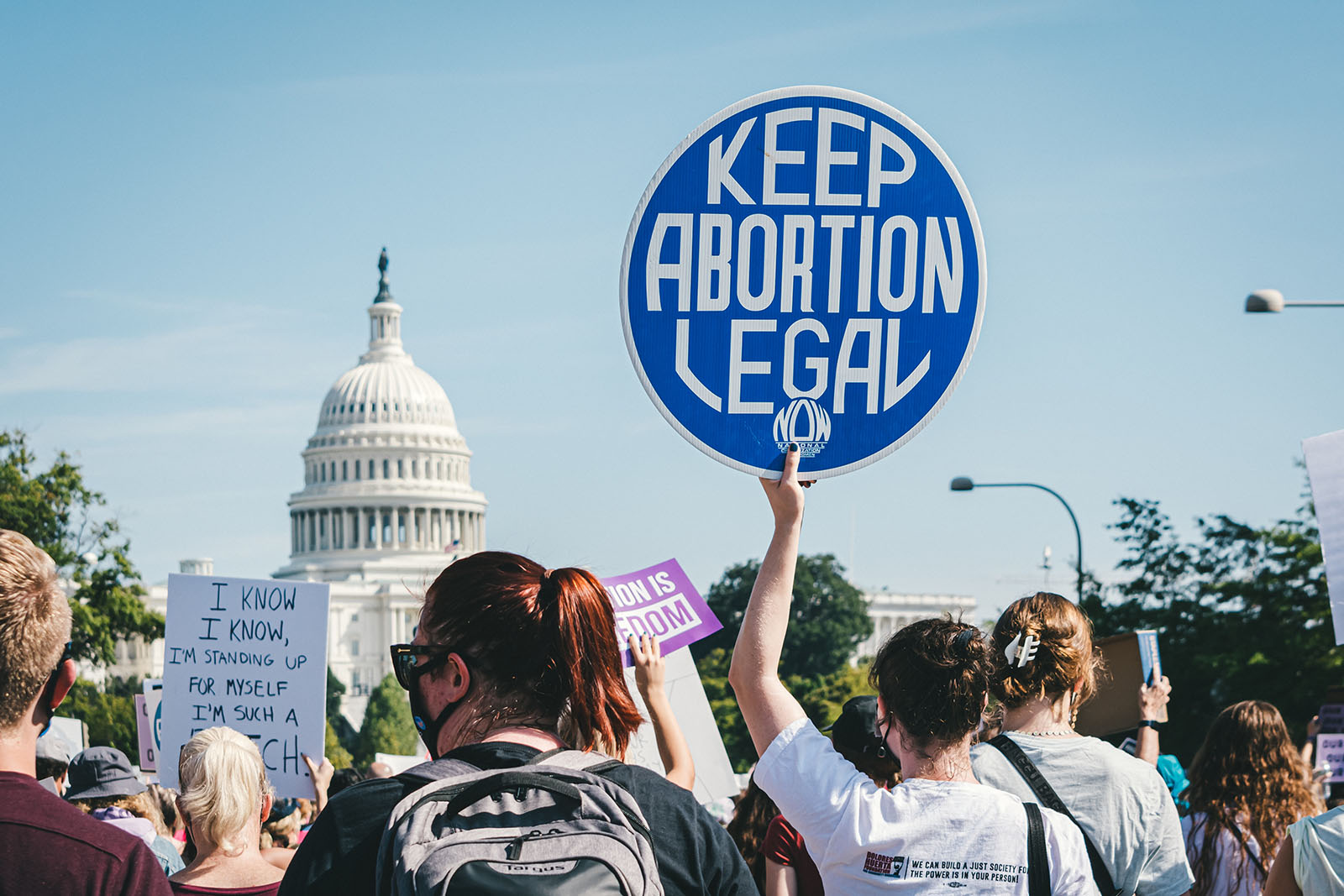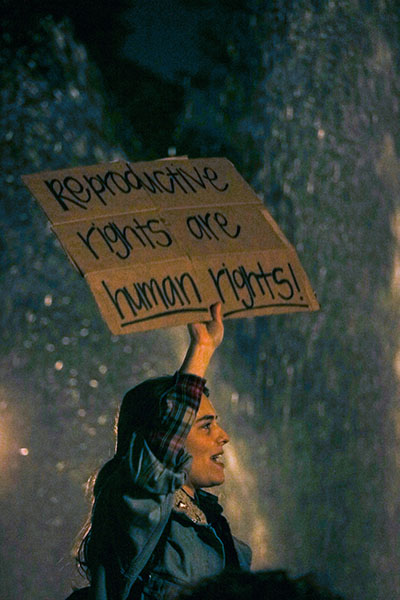
Photo by Gayatri Malhotra
“We will not go back!” “Our bodies our choice!” “Bans off our bodies!”
On June 24, these chants echoed as dissenters across U.S. cities spilled into the streets to protest the Supreme Court's decision to overturn Roe v. Wade. The 1973 decision determined that pregnant people’s Constitutional right to privacy applied to their right to receive abortions. In the case at hand, Dobbs v. Jackson Women’s Health Organization, Mississippi’s last abortion clinic challenged the state’s ban on abortion after 15 weeks. All six conservative justices, Justices Samuel Alito, Neil Gorsuch, Clarence Thomas, John Roberts, Brett Kavanaugh, and Amy Coney Barrett, made up the majority in the 6-3 decision with liberal Justices Stephen Breyer, Sonia Sotomayor, and Elena Kagan dissenting.
The ruling marked a dark turn for reproductive rights in America and left many feeling helpless and uncertain. Here is what you need to know about it:

Within days of being released, the Dobbs decision had a serious impact across the country. Abortion is completely outlawed in multiple states with trigger bans that went into effect immediately. These states include Alabama, Arkansas, Missouri, South Dakota, North Dakota, West Virginia, Wisconsin, and Oklahoma. On June 27, a federal judge in Utah put a temporary 14-day restraining order on the state’s trigger ban following a lawsuit from the Planned Parenthood Association of Utah (PPAU). Federal judges in Kentucky and Louisiana have also temporarily blocked trigger bans in their states. On July 1, the Texas Supreme Court granted a court order that allowed for a 1925 pre-Roe abortion ban to take immediate effect in the state, though the Center for Reproductive Rights has maintained this order cannot be enforced criminally.
The list of states where abortion is banned or limited is expected to grow to include about half of the U.S., and bans in Wyoming, Idaho, Arizona, Tennessee, and Mississippi are either scheduled to take place before or by the end of July or will likely go into effect within the next two months. On July 5, a judge in Mississippi blocked a request to by the state’s only aborton clinic to temporarily block a law that would ban abortion in the state by July 7. Abortion is banned after six weeks of pregnancy in Ohio, South Carolina, and Tennessee and after 15 weeks in Florida. Georgia’s 2019 Living Infants Fairness and Equality (LIFE) Act would ban most abortions after a fetal heartbeat is detected and could take effect soon. To stay updated on ongoing state-by-state abortion bans and legislation, follow The New York Times’s tracker here.
Many state legislatures adjourned for the summer, but, according to The Washington Post, some governors, such as Nebraska’s Pete Ricketts, have expressed interest in convening special sessions to speed up the bans.
Following the Supreme Court’s decision, Mike Pence expressed his desire for a national abortion ban to Breitbart News: “We must not rest and must not relent until the sanctity of life is restored to the center of American law in every state in the land.”
In July, President Joe Biden signed an executive order to protect abortion rights. The order declared that Attorney General Merrick Garland must convene lawyers as well as organizations to help legal representation for people seeking reproductive care. Like several companies, Biden also extended leave to federal workers traveling to get an abortion.
While the decision to overturn Roe may have seemed sudden, it was the result of decades of anti-abortion activism from Republicans. The emergence of the Christian right as a powerful voting bloc was spurred by a backlash to segregation, offering an opportunity for conservatives to siphon off White, rural voters from the left. In the late 1970s, the founder of the Heritage Foundation, Paul Weyrich, saw abortion as a way to fire up and consolidate the evangelical vote. This gave way to the modern conservative framing of abortion as murder.
Although Roe was a victory for pro-choice advocates, Republicans have used the courts as a convenient way to achieve minority rule since the 1970s and have worked to chip away at Roe. In the 1980s, they were bolstered by the popularity of the Federalist Society, who championed originalism, the interpretation of the constitution that prioritized the founders’ intent above all else.
In 1992, conservatives were unsuccessful in overturning Roe in Planned Parenthood v. Casey, but that case allowed them to limit abortion in ways that did not create an “undue burden” on the people seeking it. This decision set the precedent for a wave of Target Regulation of Abortion Providers (TRAP) laws, which tested the subjective limit of what an “undue burden” could mean.
The conservative reshaping of the Supreme Court was finalized by Donald Trump who vowed to only appoint anti-choice judges, and, with one seat stolen from the Obama administration, was able to appoint three of the six judges who struck down Roe.
Women will certainly feel the impact of Roe’s reversal, particularly poor women and women of color. It’s also important to remember that not all people who can get pregnant are women. Transgender and nonbinary people often face an even more complicated and stigmatized path to reproductive freedom than cis women, which is rarely addressed by the mainstream reproductive rights movement.
The trans community has already faced a tidal wave of attacks from state legislatures this year, and without the right to privacy that Roe established, trans people are in an even more dire position. Without the opportunity to get an abortion, trans people will be forced to carry out pregnancies they do not want, which, in some cases, can lead to feelings of gender dysphoria and other mental health concerns. This forced pregnancy serves as a nonconsensual outing that would likely incite more violence against a targeted community that experienced its deadliest year in 2021.
According to Mckinsey & Company, trans people make 32% less money than their cisgender counterparts and are twice as likely to be unemployed. Trans people of color face even greater discrimination and are homeless at five times the rate of the general population. Because they are so economically vulnerable, trans people will have even more difficulty obtaining the money and transportation to take them to states where abortion is protected. A 2017 UCLA study found that trans-identifying people were disproportionately minors between the ages of 13 and 17. For minors, these difficulties will likely be compounded by demands for parental consent that exist even in pro-choice states.
It’s hard to overstate the enormity of the Dobbs decision and subsequent Roe reversal on the future of freedom in the U.S. Justice Samuel Alito wrote in the majority opinion that “nothing in this opinion should be understood to cast doubt on precedents that do not concern abortion." He justified this by implying that abortion was an outlier because it destroyed a “potential life.” This statement does not necessarily hold any truth; Justices Kavanaugh, Barrett, and Gorsuch have all previously stated in their nomination hearings that Roe and Casey were settled precedent.
In his concurring opinion for Dobbs, Justice Thomas called into question Griswold v. Connecticut, a 1965 decision granting married couples the right to contraceptives; the 2003 decision Lawrence v. Texas that prohibited states from banning gay sex; and 2015’s Obergefell v. Hodges, which legalized gay marriage.
The Dobbs decision rests on a strict understanding of the Ninth Amendment, which says that just because a right isn’t listed in the Constitution, that doesn’t mean it doesn’t exist. In Dobbs, six justices argued that these “unenumerated” rights have to be deeply rooted in American tradition for them to exist, a test that would challenge modern movements, including the reproductive justice movement and LGBTQIA+ equality.
The dissenting justices called out the hypocrisy in the decision, noting that Roe served as precedent for Griswold, Lawrence, and Obergefell and that without Roe those decisions become vulnerable to be repealed as well. They wrote, “Either the mass of the majority’s opinion is hypocrisy, or additional constitutional rights are under threat. It is one or the other.”
Despite how gutting this ruling is to those in support of abortion rights, it’s clear the fight for reproductive freedom is far from over. The 2022 midterms will take place in November and will determine control of Congress and whether Democrats will have the power to codify abortion rights into law.
BuzzFeed compiled a list of ways to advocate for abortion now that Roe has been overturned. It includes calling your representatives at both the federal and local level, volunteering as a clinic escort, and donating money to local abortion funds. Renee Bracey Sherman, founder of the nonprofit group We Testify, suggested donating to Keep Our Clinics, which helps independent abortion clinics.
For people seeking an abortion, the organization Plan C helps people access at-home abortion care. Amid growing concerns that personal data will be used to prosecute people seeking abortion, there are resources to help navigate around that. New York Representative Alexanrida Ocasio-Cortez shared a primer on privacy from the Electronic Frontier Foundation. The Digital Defense Fund also has a guide on abortion privacy that includes links to protected browsers and search engines, such as DuckDuckGo and Firefox Focus.
Sophie Hayssen is a Brooklyn-based writer and editor who covers politics and culture. Her work has appeared in Teen Vogue, Bitch Media, and Input Magazine, among others.